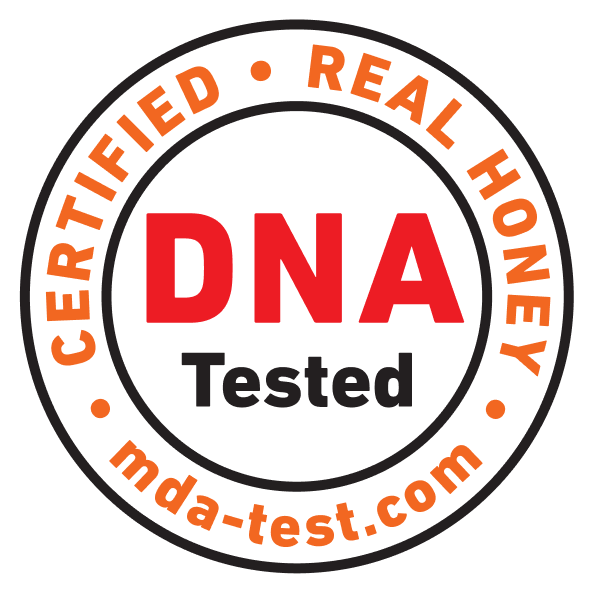
Honey Metagenomic DNA Analysis (MDA)
The MDA test detects DNA sequences of more than 10,000 different plant, bacterial, fungal, insect and mammalian species in a honey sample.
What is honey MDA?
What does the Honey Metagenomic DNA Analysis (MDA) show?

Honey plants
- Honey contains the DNA of all the species bees come in contact with.
- DNA analysis can identify over 5,000 plant species from a honey sample.
- The study includes pollen, nectar, and honeydew plants.
Identification of plants in honey DNA analysis
- All plants whose gene sequences are in world databases are identified.
- The average honey sample contains traces of DNA from tens or hundreds of plant species; pollen plants, nectar plants and honeydew plants.
- The amount and selection of plants found in the honey depends on the richness of species in the collection area, collection preferences of the bees, weather, etc.
- In addition to the composition of honey DNA plants, the analysis compares with other honey profiles; what kind of plants there are more or less in the analyzed sample compared to other honeys. The list of comparable plants is HERE
How does honey DNA analysis work?
- The sample reaches to the laboratory
- HMF concentration and moisture percentage are measured
- DNA (of plants, animals, bacteria, insects, fungi, etc.) is extracted
- Amount and quality of DNA is evaluated
- DNA sequences are determined by sequencing technology
- Based on DNA sequences, the composition of the organisms in the honey is analyzed
- DNA composition of the honey is compared against an authentic honey profile database

Honeybee pathogens and parasites
- Honey contains DNA from pests (bacteria, fungi, and arthropods).
- DNA analysis detects 20 important pathogens or parasites in a honey sample.
- The analysis includes agents of American and European foulbrood, Nosematosis, Chalkbrood and other diseases.
Determination of bee pathogens and parasites
- Pathogens and parasites associated with bees are identified, including bacteria, fungi, and arthropods. Read more information HERE.
- 20 essential pathogens and parasites were selected for honey DNA analysis. The list can be found HERE.
- As a result of the analysis, the relative amount of the pathogen or parasite in the examined sample can be found compared to other honey.
What can be found out with honey DNA analysis?
- What kind of plant’s nectar and pollen the honey is made from?
- What kind of plants have more DNA in the analyzed sample compared to the profiles of other honeys?
- Can honey be monofloral on some plants?
- Are there traces of DNA of pathogens/parasites associated with bees in the analyzed sample?
- Information about the honey's quality, authenticity, and geographical origin.

Quality, authenticity and origin of honey
- The DNA profile of authentic honey consists of DNA sequences from plants, bacteria, fungi, and insects.
- Based on the DNA profile, the quality, authenticity and geographical origin of the honey are evaluated.
- Changes and manipulations with honey DNA profile are easily detectable.
Detection of honey adulteration
Detection of honey adulteration is carried out in two stages:
- The amount and quality of honey DNA is evaluated. Authentic and unprocessed honey contains high concentrations of undegraded DNA.
- The honey DNA profile is compared against a comprehensive honey DNA database. Deviations can be in both the species composition and quantitative ratio of different species.
Each honey has a unique composition and does not resemble entirely to any other honey. The DNA profiles of authentic honeys with naturally diverse compositions share certain common patterns. Significant deviations in honey DNA profiles are identified using a machine-learning method of data analysis. Therefore, changes and manipulations with the honey DNA profile are easily detectable.

Advantages of honey DNA metagenomic analysis

The MDA test analyzes entire DNA contained in the honey, which opens a significantly wider view of the sample than, for example, PCR or DNA barcoding tests.

The MDA test detects the presence of DNA traces of more than 10,000 different species of plants, bacteria, fungi, insects, mammals, etc. in the honey sample.
In addition to pollen plants, MDA also detects nectar and honeydew plants, and DNA traces of bee pathogens or parasites.

To analyze the DNA profile of honey, 10-20 million DNA sequences are created, which provides comprehensive information about the honey sample.

The DNA profile of each honey is unique and cannot be imitated artificially. During MDA, machine learning methods are used to detect deviations from DNA profiles of previously analyzed authentic (reference) honeys.
The power of honey DNA test in numbers
The number of DNA sequences per sample

10-20 million
The number of species that can be identified (plants, bacteria, fungi, arthropods etc.)

10,000+
Plant species whose DNA can be detected with the test

5,000+
The most important honey bee pathogens and parasites

20
The result report of honey DNA analysis is sent electronically in two files:
- The composition of plants is presented as an interactive report.
- A detailed PDF report shows the comparison with DNA profiles of other honeys (plants, bee pathogens and parasites), and the authenticity and origin of the honey.

Ordering MDA test
- The MDA test can be ordered by a private person, a self-employed person, a nonprofit association, or a company.
- 100 g of honey is required for the test.
- After the ordering we will send out the order form and sample collection instructions.
- The price of the test is 250 euros + VAT

Our client may use the DNA-proof label when marketing honey. The client may only use the label on honey batches tested by Celvia CC and certified as authentic. The label in English is part of the analysis report. Other languages are available upon request.

Kairi Raime PhD

Kaarel Krjutškov PhD

Signe Mölder MSc

















